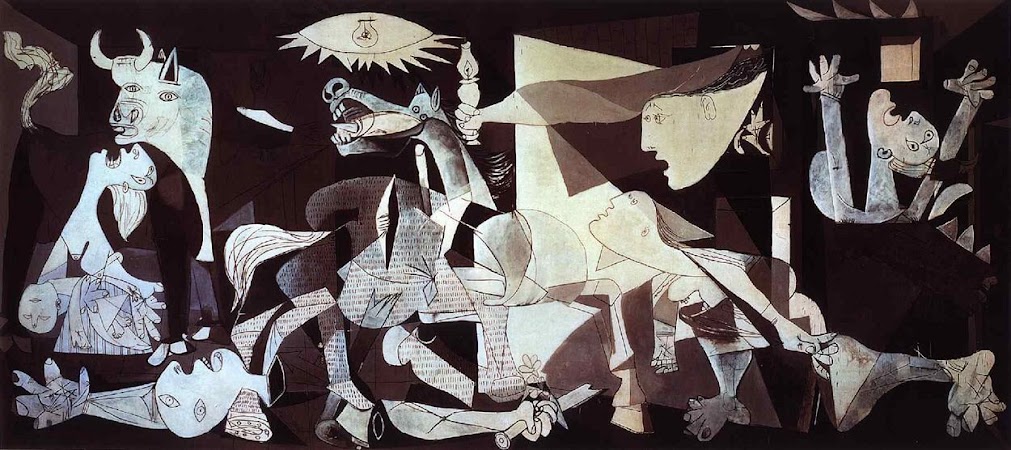Pablo Picasso
Guernica, c. 1937
Oil on canvas
349.3 cm × 776.6 cm (137.4 in × 305.5 in)
Museo Reina Sofía, Madrid, Spain
On Monday, 26 April 1937, warplanes of the Nazi Germany Condor Legion, commanded by Colonel Wolfram von Richthofen, bombed Guernica for about two hours. In his 30 April 1937 journal entry von Richthofen noted that when the squadron arrived "there was smoke everywhere" from the attack by three aircraft, and since nobody could see the roads, bridges, and suburbs "they just dropped everything right into the center. The 250s toppled a number of houses and destroyed the water mains. The incendiaries now could spread and become effective. The materials of the houses: tile roofs, wooden porches, and half-timbering resulted in complete annihilation." More on Guernica
Probably Picasso's most famous work, Guernica is certainly his most powerful political statement, painted as an immediate reaction to the Nazi's devastating casual bombing practice on the Basque town of Guernica during the Spanish Civil War.
Guernica shows the tragedies of war and the suffering it inflicts upon individuals, particularly innocent civilians. This work has gained a monumental status, becoming a perpetual reminder of the tragedies of war, an anti-war symbol, and an embodiment of peace. On completion Guernica was displayed around the world in a brief tour, becoming famous and widely acclaimed. This tour helped bring the Spanish Civil War to the world's attention.
More on this painting
The government of the Spanish Republic acquired the mural "Guernica" from Picasso in 1937. When World War II broke out, the artist decided that the painting should remain in the custody of New York's Museum of Modern Art for safekeeping until the conflict ended. In 1958 Picasso extended the loan of the painting to MoMA for an indefinite period, until such time that democracy had been restored in Spain. The work finally returned to this country in 1981.
More on this painting
Pablo Ruiz Picasso (25 October 1881 – 8 April 1973) was a Spanish painter, sculptor, printmaker, ceramicist and theatre designer who spent most of his adult life in France. One of the most influential artists of the 20th century, he is known for co-founding the Cubist movement, the invention of constructed sculpture, the co-invention of collage, and for the wide variety of styles that he helped develop and explore. Among his most famous works are the proto-Cubist Les Demoiselles d'Avignon (1907), and the anti-war painting Guernica (1937), a dramatic portrayal of the bombing of Guernica by German and Italian air forces during the Spanish Civil War. More on Pablo Picasso
Please visit my other blogs: Art Collector, Mythology, Marine Art, Portrait of a Lady, The Orientalist, Art of the Nude and The Canals of Venice, Middle East Artists, 365 Saints, 365 Days, and Biblical Icons, also visit my Boards on Pinterest
Images are copyright of their respective owners, assignees or others. Some Images may be subject to copyright
I don't own any of these images - credit is always given when due unless it is unknown to me. if I post your images without your permission, please tell me.
I do not sell art, art prints, framed posters or reproductions. Ads are shown only to compensate the hosting expenses.
If you enjoyed this post, please share with friends and family.
Thank you for visiting my blog and also for liking its posts and pages.
Please note that the content of this post primarily consists of articles available from Wikipedia or other free sources online.

No comments:
Post a Comment